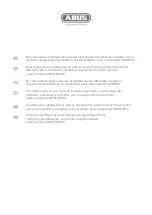
V10K V-NOTCH CHLORINATOR
WT.025.100.001.UA.IM.0614
55
EVOQUA
W3T109612
c. Using running water or a cup full of water and a small, stiff brush (such
as an old toothbrush), scrub out the V-notch groove and the shank of the
plug.
WARNING: DO NOT USE HYDROCARBONS OR ALCOHOLS BECAUSE
RESIDUAL SOLVENT MAY REACT WITH THE GAS. SOLVENTS CAN PRO-
DUCE SERIOUS PHYSIOLOGICAL EFFECTS UNLESS USED IN STRICTEST
COMPLIANCE WITH THE SOLVENT MANUFACTURER’S SAFETY RECOM-
MENDATIONS.
d. Do not soak the plug in solvent. Do not use a knife or scraper or a file to
clean out the groove. Dissolving action and scrubbing are all that is required.
e. Dry the plug with a clean cloth or paper towel.
f. Remove seal clamping screw. Clean and inspect orifice and O-rings and
replace if necessary.
g. Wipe a thin film of Halocarbon grease on the O-rings and the threads of the
V-notch assembly. Reinstall it in the control panel and resume operation.
4.6.3
Zero Position of V-Notch Plug for Electric Control
When the electronic controller is receiving a zero flow signal, adjust lock nut
and coupling screw until the V-notch is at its zero position, then tighten.
To determine this position, proceed as directed in preceding Step b. Automatic.
With the V-notch plug and plug stem in the extension chamber and the orifice
seated, move the plug stem in or out as required until the scratch line on the
bottom of the plug is even with the bottom of the orifice as viewed through
the holes in the extension chamber. Make a pencil line around the plug stem
even with the bottom of the seal clamping screw. This pencil line may then be
used as a zero reference when the parts are reassembled in the control unit
and the linkage is adjusted to match the zero of the electric actuator.
4.6.4
Cleaning Injector Throat and Tailway
Water containing carbonates, manganese or iron will frequently leave a deposit
in injector tailways. As this deposit increases in thickness it can become scaly
and rough and adversely affect pressure recovery or increase backpressure so
that the injector fails to develop adequate operating vacuum. If the upstream
strainer becomes corroded or perforated and passes a small pebble or other
tramped material, such particles can partially plug the throat and prevent ad-
equate flow. Water containing suspended silt or sand particles can erode the
opening in the throat. As this opening is enlarged, the water velocity decreases
and the vacuum developed also decreased.
Deposits may be removed by immersing the throats in dilute (10%) hydrochloric
acid, known commercially as muriatic acid.
!
Summary of Contents for V10K
Page 1: ...V10K V NOTCH CHLORINATOR BOOK NO WT 025 100 001 UA IM 0614...
Page 2: ...V10K V NOTCH CHLORINATOR BOOK NO WT 025 100 001 UA IM 0614 W3T109612...
Page 12: ......
Page 23: ......
Page 45: ...WT 025 100 001 UA IM 0614 V10K V NOTCH CHLORINATOR 32 EVOQUA W3T109612...
Page 46: ......
Page 61: ......
Page 90: ......
Page 131: ......
Page 133: ......
Page 134: ...CHLORINE HANDLING MANUAL Cl2 BOOK NO WT 025 000 001 UA IM 0614 W3T98244...
















































